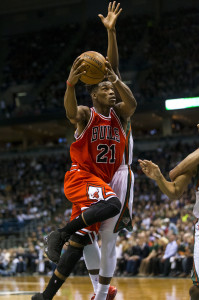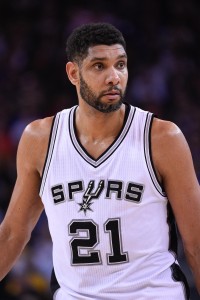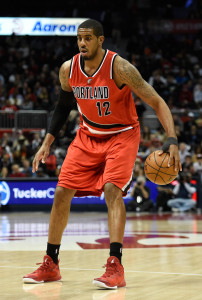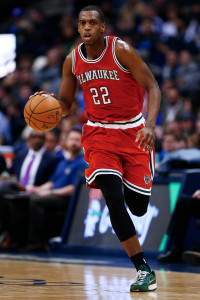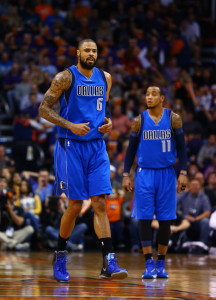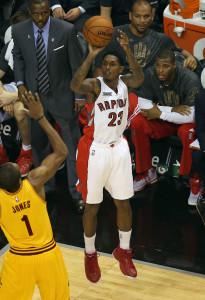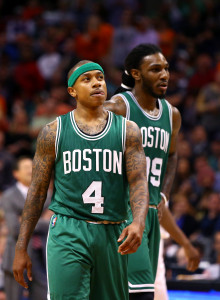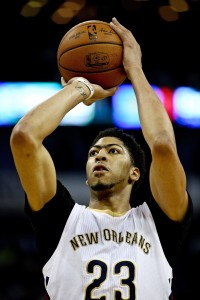Guaranteed Contracts
- Derrick Rose ($20,093,064)
- Joakim Noah ($13,900,000)
- Taj Gibson ($8,500,000)
- Pau Gasol ($7,448,760)
- Nikola Mirotic ($5,543,725)
- Doug McDermott ($2,380,440)
- Tony Snell ($1,535,880)
- (Richard Hamilton $333,333)1
Non-Guaranteed Contracts
- E’Twaun Moore ($1,015,421)2
- Cameron Bairstow ($845,059)3
Options
- Kirk Hinrich ($2,854,940 — Player)4
Restricted Free Agents/Cap Holds
- Jimmy Butler ($5,021,870) — $4,433,683 qualifying offer
Unrestricted Free Agents/Cap Holds
- Mike Dunleavy ($4,324,106)
- No. 22 pick ($1,159,300)
- Aaron Brooks ($947,276)
- Nazr Mohammed ($947,276)
Draft Picks
- 1st Round (22nd overall)
Cap Outlook
- Guaranteed Salary: $60,160,202
- Non-Guaranteed Salary: $1,435,480
- Options: $2,854,940
- Cap Holds: $12,399,828
- Total: $76,850,450
Most Bulls fans would probably have been ecstatic if you told them a year ago that their team would sign a free agent who’d score 18.5 points per game this season, that Nikola Mirotic would finish second in Rookie of the Year Voting, and that Derrick Rose would play in every playoff game. Add that Jimmy Butler would take a massive leap offensively, average 20.0 PPG, and win the Most Improved Player award, and those fans might have begun scouting locations in Grant Park for the championship celebration. Instead, a cloud of gloom seems to hang over the franchise in spite of all the positives that happened in the past year. Management is nearing an ugly split with coach Tom Thibodeau, and the sting of a missed opportunity in the playoffs is such that it’s left some, including Grantland’s Zach Lowe, to wonder if we’ve seen the last of the Bulls as we know them.
What seems almost certain now is that Thibodeau won’t be back. Iowa State coach Fred Hoiberg appears to be the team’s first choice to replace the former Coach of the Year, but Hoiberg is only a month removed from open heart surgery, and there’s some doubt that he wants to embrace the NBA pressure for this coming season. One source told Bleacher Report’s Howard Beck that Warriors assistant Alvin Gentry is the favorite for the job, but he’s tied up with Golden State’s run for a title, and there’s no telling if he wants to try to work with a front office that apparently can’t get along with the well-respected Thibs. Bulls lead assistant Adrian Griffin is an intriguing in-house candidate, but he’s never been a head coach on any level.
Whoever coaches the Bulls next season will likely have to reckon with the notion that as strong Chicago’s roster is, Cleveland’s seems even stronger. The Cavs beat the Bulls without Kevin Love and Anderson Varejao for the entire series, without J.R. Smith for the first two games, and without whatever asset they’re poised to reap from the unusually valuable Brendan Haywood contract. Pau Gasol, that 18.5 PPG scorer the Bulls picked up in free agency last summer, turns 35 in July. Executives around the league apparently aren’t convinced that Joakim Noah will ever again be healthy enough to perform at his peak level. Rose looked at times like his pre-injury self in the playoffs and averaged 20.3 points per game, but he missed 31 regular season games and he, too, doesn’t appear capable of regaining all that he once had.
The good news for the Bulls is that they have the power to retain Butler for at least next season, and at least the next three seasons barring the thoroughly unlikely outcome that Butler signs his qualifying offer, worth slightly less than $4.434MM. The Bulls can preclude any opposing team from tendering an offer sheet like the one Chandler Parsons signed in 2014, which includes a player option after year two, if they make a maximum qualifying offer alongside Butler’s standard qualifying offer. The maximum qualifying offer is a five-year guaranteed deal for the max with full 7.5% raises and no option clauses. It sounds like the Bulls already have that kind of offer in mind anyway, and executive VP of basketball operations John Paxson has said Chicago will match all other offers, so Butler seems destined to remain with the Bulls for the foreseeable future.
Still, even securing Butler this summer will come with a tinge of regret for the team, since he and agent Happy Walters would reportedly have been willing to settle for an extension with salaries between $12.5MM and $13MM this past fall, when the team held the line at $11MM a year. The starting salary in a new max deal for Butler would likely approach $16MM. Sign Butler to the max, and Chicago’s staring at some $76MM in guaranteed salary for only eight players on the roster. That doesn’t include starting small forward Mike Dunleavy, who’s hitting unrestricted free agency, Kirk Hinrich‘s nearly $2.9MM player option, or the team’s draft pick this year, which comes at No. 22. The tax line is projected to be $81.6MM, and owner Jerry Reinsdorf isn’t known to be enthusiastic about shelling out extra money on his payroll. Reinsdorf might be particularly eager to keep costs in check after paying $13.549MM to the amnestied Carlos Boozer this year on top of the team’s more than $67.4MM in cap hits.
Chicago has little recourse to avoid the tax unless it feels as though an alternative to Dunleavy at small forward is already on the roster or unless it pulls off a salary-clearing trade. Doug McDermott didn’t win Thibodeau’s confidence in his rookie season, averaging 8.9 minutes per game across only 36 appearances, but last year’s 11th overall pick still holds promise as a potential solution at the three spot. Tony Snell showed improvement as he took on an increased role this past season, so perhaps he’s ready to take another leap into the starting lineup on the wing alongside Butler. Chicago could go big and start Mirotic or Taj Gibson at the three, though that would be a rather radical move in today’s NBA.
Gibson’s name comes up more often in trade speculation than in suggestions that he should start these days after his playing time receded this year. That reduced burn was largely a function of the acquisitions of Gasol and Mirotic, since there are only so many frontcourt minutes to go around. Still, his PER held steady at 16.1, virtually mirroring last season’s 16.0, a number he posted amid the most expansive role of his career as the Bulls de-emphasized Boozer. Gibson’s $8.5MM salary and his ability to start for another team make him a logical trade candidate, and the Bucks and Raptors, among others, seemed interested. However, talks never appeared to get very far, signaling that Chicago didn’t have much inclination to part with him.
Another mechanism of breaking up the frontcourt logjam would be to move Gasol, whose trade value may never be higher than it is now in the wake of a renaissance season. His contract is ostensibly even more attractive to opposing teams than Gibson’s is, as it calls for him to make nearly $7.449MM next season with a player option worth almost $7.77MM in 2016/17. That would make him a fit for a team even if he were only playing at the level of a rotation-caliber reserve. However, the Bulls would be stuck paying a trade kicker worth $1,117,314 if they were to trade Gasol this summer, and it’s difficult to envision another team coming up with a fair package in exchange that would lessen Chicago’s salary burden for next season.
Trading Noah is another possibility, but not one that seems like it would be all that attractive to the Bulls, either. Chicago would be selling low on the 2013/14 All-NBA First Team center who’s been as much a part of the fabric of the Bulls as anyone. The continued presence of Noah would help keep the locker room together amid transition from Thibodeau to the next coach. Noah’s contract is up after next season, so if he fails to return to top form, the Bulls wouldn’t have any further commitment tying them to him.
Noah’s deal coming off the books isn’t the only reason why the team will have much more flexibility after next season than it does after this one. The sudden jump in the salary cap and the tax line will make it much easier for the Bulls to avoid tax penalties, meaning that a venture into the tax this season would set up as a one-year phenomenon that wouldn’t put the team in line to pay repeat-offender penalties anytime soon. Chicago has only paid the tax once in its history, and this season’s Boozer payment has been an added burden. Still, the league’s $24 billion TV deal brings the promise of greater revenue than ever, and with it, the capacity for owners to shell out even more for talent, even on top of what the rising salary cap will compel them to pay.
Ultimately, the decision about whether to make a concerted effort to avoid the tax or to move in the other direction and keep the team intact may well rest largely in the front office’s read on the degree of separation between this team’s title chances in the next few years and those of the Cavs. It’s conceivable that Paxson and GM Gar Forman will conclude that this roster just isn’t capable of scaling those last hurdles to a championship. The apparent urge to move on from Thibodeau is either a signal from management that it feels like another coach would help bring the team that extra step closer or that the club has to rebuild to some degree and thus it isn’t worth putting up with whatever it is Thibs does that’s so irksome. Last year, the Bulls looked outside of themselves, to Carmelo Anthony, to Love and finally to Gasol, to move ahead. The summer ahead will be a time for Chicago to look inward, and it’ll say much about the way the Bulls perceive themselves.
Cap Footnotes
1 — The Bulls waived Hamilton in July 2013 and used the stretch provision to spread his remaining guaranteed salary over the next three seasons.
2 — Moore’s salary becomes fully guaranteed if he remains under contract through July 25th.
3 — Bairstow’s salary is partially guaranteed for $425K.
4 — The cap hold for Hinrich would be $5,190,800 if he opts out.
The Basketball Insiders Salary Pages were used in the creation of this post.
